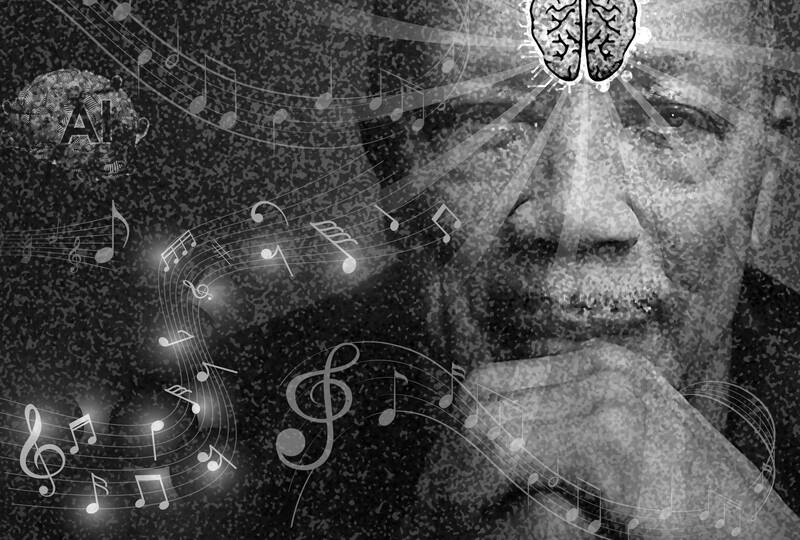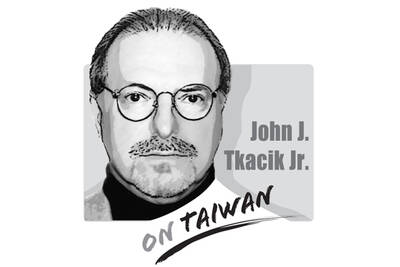If you were trying to build an artificial intelligence (AI) model that could make great music, the work of legendary producer Quincy Jones, who died last week aged 91, would be the ultimate dataset.
He was taught by Ray Charles, composed for Count Basie and played trumpet for Elvis Presley.
He arranged and conducted Frank Sinatra’s big band. He produced Michael Jackson’s Off The Wall, Thriller and Bad. He composed the soundtracks for more than 30 movies, including The Color Purple and The Italian Job. Jones’ Soul Bossa Nova is the theme tune in your head when you think of Austin Powers. Spanning every imaginable contemporary genre, Jones’ catalog is history.

Illustration: Louise Ting
Yet, even if you ingested all those years of incredible work, you would still not have a Quincy Jones or anything like him.
As I reflect on his life and consider how he worked, I find myself more reassured than ever that attempts to replace the hard and beautiful creative process with AI would forever fall hopelessly short.
Some people think it can be done. That, by feeding hour after hour of great music into an Nvidia-powered data center, you would eventually conjure a machine capable of creating new, original work worth paying attention to. Suno, valued at US$500 million, is one such company. It is “building a future where anyone can make great music,” it said. “No instrument needed, just imagination.”
What they are describing is a shortcut — something Jones, throughout his career, had little time for. He was extremely meticulous in deciding who to work with. In his later years, he railed against the lack of mastery some modern artists were able to get away with, thanks to technology filling in the gaps.
An important part of the creative process, he once remarked, was forcing the artists he worked with to prioritize only their best work. This was helped by the technological limitations of the time.
In interviews about the making of Thriller, Jones described an agonized Jackson whittling down dozens of songs to just nine so they could fit onto a vinyl record.
A brutal exercise, but one which left the album, the best-selling of all time, without a single second of filler. (It is something we might long for today. It is the limitlessness of streaming sites like Spotify that enabled Taylor Swift to put out a two-hour-long album that was “conspicuously wanting for an editor,” one review said.)
With AI, it feels like there would soon be even fewer limitations and less need than ever for real talent or difficult decisions, but it is a mirage.
One of my favorite pieces of writing on AI this past year came from sci-fi author Ted Chiang, whose New Yorker essay “Why AI Isn’t Going To Make Art” said that art, in its many forms, “is something that results from making a lot of choices.”
Chiang used the example of a writer deciding what words to write: a 10,000-word story is, in simple terms, 10,000 choices, each swayed by the author’s unique perspective, lived experience, mood, sobriety, pressure and so on. When you hand that job to AI, those choices belong to the machine. They become a synthesis of choices already made by others and therefore would never truly surprise us or move us forward.
Also embedded in an artist’s work are the choices of countless others. The choice, for instance, of a Welsh slave owner to, Jones believed, rape a woman he enslaved, who would then birth Jones’ father.
Or the choice of many hotel and restaurant owners to deny Jones and his bandmates a bed or a meal on account of their skin color (on one occasion forcing them to spend the night in a funeral parlor). Or, indeed, the choice of Jones himself to father seven children with five women.
What all this amounts to cannot be measured. It certainly cannot be written in software code, and you cannot tell me that these choices were not deeply present in Jones’ work, or behind his drive to do so much of it. There is no question we have more to gain from art made by flawed human beings than by sterile software.
Backers of this technology say it can only get better and more convincing. I say it would never be good enough.
By its nature, AI is only capable of remixing past work into forms that might sound good enough to fool our eyes and ears, but it would always fall short of fooling our minds. In that sense, perhaps our greatest defense against AI in the arts is good taste.
It was who Jones was as a person, not just a musician, that meant he was able to apply his genius across genres and cultures, making his work so compelling.
With Jackson’s Thriller, he blended the genres of rock, R&B and pop in a way that forced MTV to give up the racist policies that kept black artists off its station. With The Fresh Prince of Bel Air, Jones sold TV executives on the value of a story of a young, working-class black teenager confronting his new life in a confusing upper-class world.
None of this work could have been done by AI. None of it. Not the idea generation, composition, performing, scriptwriting or editing.
Proponents of AI music would say mixing two or more genres in a “new” composition is absolutely possible. On its face, it is: You can tell Suno to create a “rock song with Latin influences,” for instance, and it would do it in seconds, vocals and all, but who wants to hear it? It comes from nowhere, from no one and means nothing.
Those who say AI can be used for “easier” tasks in music — say, like a jingle — could well be depriving future great artists of a way to support themselves as they are starting out.
If you want to see Jones at his very best, and be as confident about the future as I am, I would suggest watching The Greatest Night in Pop, a documentary released in January by Netflix.
It pieces together behind-the-scenes footage of the making of the 1985 charity single, We Are The World, which Jones produced. It was his influence that helped bring a diversity of artists to a studio to work through the night.
Like a masterful schoolteacher, Jones corralled a choir of egos, reined in the mischievous Stevie Wonder, and put a shy and uncomfortable Bob Dylan at ease. “I know you know,” said Dylan when Jones reassured him his vocal was up to par.
How did Jones “know”? Experience, talent, technical brilliance, hard work — yes, but above all, humanity, and everything that goes with it — a trait no AI would ever possess.
Dave Lee is Bloomberg Opinion’s US technology columnist. He was previously a correspondent for the Financial Times and BBC News. This column does not necessarily reflect the opinion of the editorial board or Bloomberg LP and its owners.

Somehow, US intelligence identified “the Houthis’ top missile guy” and pinpointed his exact location. At 1348 hours (Washington time), March 15, President Trump’s national security advisor Mike Waltz texted, “positive ID of him walking into his girlfriend’s building.” The unsuspecting Romeo entered. High above, the drone monitoring the building registered a flash. When the smoke cleared, Mr. Waltz texted, “…And it’s now collapsed.” RIP. The star-crossed “top missile guy” had been target number one in the now uproarious US Navy bombing campaign on that Sunday against the Yemeni rebels who have been holding the Red Sea hostage since October 19,
Actress Michelle Yeoh (楊紫瓊) on March 13 posted an Instagram caption after the opening of Tiffany’s Taipei flagship store two days earlier that read: “Thank you Tiffany for inviting us to Taipei China.” We know that Yeoh knows Taipei is in Taiwan, not China, because the caption was posted following comments she made — in English — in which she said: “Thank you to Tiffany for bringing me to Taipei, because I do love this country very much.” Her remarks and the subsequent Instagram caption were reported in Taiwan, in Chinese and English- language media such as Radio Free Asia, and overseas,
China on Tuesday, April Fool’s Day, began two-day joint-force military exercises around Taiwan, painting them as a “severe warning and forceful containment against Taiwan independence.” However, the exercises have again proven the country increasingly showcasing its military muscles to be a true “troublemaker.” Without prior notice, the Chinese People’s Liberation Army’s (PLA) Eastern Theater Command launched large-scale exercises codenamed “Strait Thunder-2025A,” deploying aircraft, drones and naval vessels including the Shandong aircraft carrier, as well as armed militia in the air and waters around Taiwan. The PLA claimed the military exercises were practice for precision strikes and a blockade to “close
Days ago, foreign media reported that Chinese People’s Liberation Army (PLA) Eastern Theater Command Director Lin Xiangyang (林向陽) is suspected to have disappeared under suspicious circumstances. The Eastern Theater Command is the core military department responsible for operations against Taiwan — the purging of its director, if true, would be a major blow to the morale of the Chinese military and the success of its training. On Tuesday morning — April Fool’s Day — the Chinese Communist Party’s (CCP) Eastern Theater Command suddenly announced the launch of joint military exercises in the air and maritime spaces surrounding Taiwan. The exercises